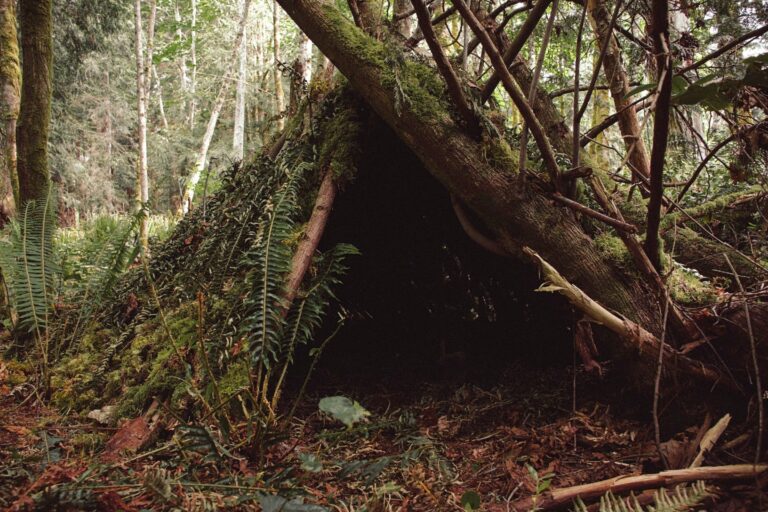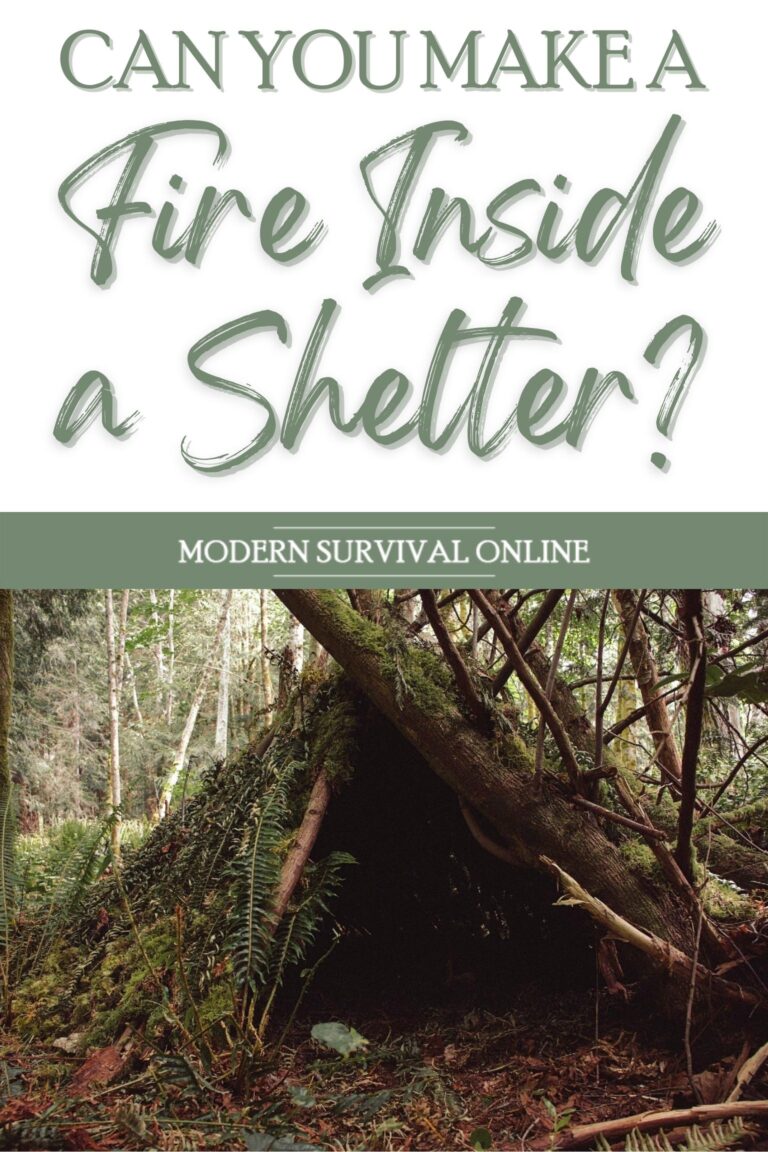One of the single most important and most fundamental survival skills is building a fire. Knowing how to build a fire will help you get dry and keep warm, as well as signaling for help and cooking food.

But, in really harsh conditions you’ll need to stay inside your shelter for safety, and this begs the question, can you make a fire inside your shelter?
Yes, it is possible to build a fire inside your shelter if you are cautious and ensure adequate ventilation. But, if your shelter is constructed from flammable materials it is not recommended unless you’re sure you can contain the fire.
It is great if you are able to build a fire inside your shelter so you can enjoy maximum protection from the elements and plenty of warmth, but it is easy for this to go terribly wrong.
Keep reading and we will tell you all about the various factors you need to understand before attempting it.
Always Consider What Your Shelter is Made From
The first and most obvious consideration when you are thinking of building a fire inside your shelter is what your shelter is made from.
Any materials that can catch fire or melt don’t necessarily disqualify you from building a fire inside, but you’ll have to be extremely cautious if you choose to.
However, shelters made from natural materials like grass, wood, leaves, pine needles, and the like might be so flammable that bringing your fire anywhere near them is a recipe for disaster.
On the other hand, something like a cave is perfect for building a fire inside under most circumstances because it cannot burn.
Then, in the middle, you have shelters like tents or houses. A large tent might support a small fire in a stove if you are extremely careful, with materials like canvas and modern synthetics proving to be quite fire resistant.
Houses might be equipped with a fireplace which is the perfect place for a fire; otherwise you’ll have to be careful that you don’t start an accidental fire in the structure.
A Fireproof Pit or Enclosure is Mandatory
Whatever kind of shelter you are occupying and however large or small your fire needs to be, it is absolutely mandatory that you provide a fireproof enclosure or surround for it. This is dependent on what you have at hand and how large the fire is.
Consider a traditional campfire. To build a campfire you first clear the ground, scratch out a pit, and then surround the pit with stones.
In a tent you might use a self-contained stove with a fuel canister or else build a small fire in a firebox set on top of a deep piece of cookware or some other fireproof object.
The idea is to prevent the fire from spreading out of control, contain small sparks and globules of smoldering sap and also prevent direct heat from melting or charring any part of your shelter.
Carbon Monoxide is a Deadly Killer
There is another major killer associated with having a fire inside any enclosed space, and that is carbon monoxide.
When any combustible fuel is burned, carbon monoxide is invariably one of the byproducts.
Carbon monoxide, or co, gas is extremely toxic, building up rapidly in the bloodstream as it poisons people who inhale it.
Carbon monoxide is a separate component of the smoke, soot, and other particulates generated when you build a fire.
It is odorless, colorless, and tasteless, and the initial effects of CO gas poisoning feel very much like fatigue or a mild illness, something a survivor might easily overlook in an already stressful situation.
After that, a headache and confusion will set in before a loss of coordination and eventually coma, then death.
There is no reasonable way to prevent the emissions of CO gas when building a fire. The only thing you can do is dissipate or evacuate the gas by ensuring good ventilation and plenty of fresh air in the area where the fire is burning.
CO gas is easily trapped in enclosed spaces and, as it cools, it sinks closer to the ground. This is obviously highly problematic if you are lying down in a tent, under a lean-to, in a cave, or something of that nature.
Most worryingly, most victims of Co gas poisoning so come while they are already asleep, meaning you could lay down at night in your shelter with a fire going feeling no ill effects, and then you’ll never wake up.
No Matter the Shelter, You Must Ensure Good Ventilation
The best thing that you can do if you are building a fire in your shelter is to ensure the space is well ventilated near the top, or that there is a positive draft coming through that blows smoke, and the co gas with it, out of the space.
This means you should always position yourself upwind of the fire whenever possible, and if you are in a space that does not allow it, then position yourself closest to the source of incoming fresh air.
Don’t Build a Fire in Your Shelter if You Have Any Worries
Remember, if you have any concerns about your shelter catching fire, melting, or accumulating hazardous gases you cannot risk building a fire inside of it.
Even if you are desperate for warmth in the situation, there are other things you can do.
You can position your fire outside of the shelter and then move yourself to receive maximum warmth from it, or supplement the inside of your shelter with an emergency blanket, foil, or some other reflector to capture more heat.
You can still make use of a fire without risking a potentially deadly accident.
Can You Build a Fire Inside Your Tent?
Yes, although any tent that has an actual floor will necessitate using some form of standoff or fireproof enclosure to prevent melting or burning.
Many people who are camping inside a tent in the coldest environments bring their camp stoves right inside for cooking.
Although much smaller and with a far more localized flame compared to a traditional campfire, you could try something similar with a compact wood-burning stove or firebox set on stones or something else that will serve as a standoff from the floor of the tent.
Remember, you must take pains to ensure the evacuation of smoke and good ventilation that will allow fresh air in.
Can You Build a Fire in a Cave?
Yes. You can build a fire inside a cave with little worry so long as you properly clear a space for it as usual, and then check to see which way the smoke is drifting.
Depending on how far in the cave you are, the slope of the cave, and which way the air is flowing in it smoke might be pulled into the cave or pushed out.
In any case, you don’t want to be breathing in smoke and CO gas, so position yourself accordingly and if possible always be nearest the fresher outside air.
Can You Build a Fire in an Igloo or Snow Cave?
Believe it or not, it is possible to build a fire inside an igloo or snow cave. Now, I know what you are thinking, as this sounds like the worst of all possible decisions.
Won’t your shelter just melt away if you do that? It could, but not necessarily, and at least you know that your shelter will not catch fire or burn around you.
It is possible to properly situate a very small fire inside an igloo or snow cave and, with good ventilation, prevent the buildup of toxic gases and also prevent it from melting around you.
Now, it is true that the fire is going to be so small it might not make a huge difference in the overall temperature inside, but even a few degrees will help stave off hypothermia and improve your comfort level.
Can You Build a Fire in a Modern Structure?
Yes, but with a caveat. If any modern structure you are occupying has a dedicated fireplace, then this is a no-brainer so long as the chimney is functional.
Otherwise, building a fire inside the structure is extremely risky, because modern homes and other buildings are very bad about trapping carbon monoxide inside.
Conventional wisdom says that you should never attempt this if the building does not have a fireplace.
If you are forced for whatever reason to build a fire inside a structure without the benefit of a fireplace, you must take great care to fireproof the floor and use a raised, completely fireproof enclosure or container to hold a small fire.
As always, do everything you can to get smoke out of the building and prevent the build-up of carbon monoxide.
If at all possible, have a battery-powered carbon monoxide detector in the room and in your immediate vicinity.


Like what you read?
Then you're gonna love my free PDF, 20 common survival items, 20 uncommon survival uses for each. That's 400 total uses for these dirt-cheap little items!
We will not spam you.